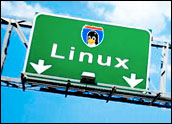
Linux has long been a contender in the corporate world to Windows. In addition, consumer interest is on the rise for this free, open source alternative to Windows or the Macintosh OS.
In the days before the graphical user interface (GUI), which was first made popular by Apple and then cloned by Microsoft., the computing world was ruled by the command-line structure. Whether the operating system was Unix or DOS, graphics and audio capabilities were limited. Computer users typed commands at a prompt to run programs. Pointing devices did not exist and menus were rudimentary, text-based options lists.
Linux developed along similar lines as Windows in terms of GUI and performance capabilities with one major distinction — upgrading from one Windows version to another was fairly seamless. Not so with Linux.
“Linux dominates the server market and is making big inroads into the embedded market (TiVo, cell phones, PDAs and routers),” Patrick Davila, co-host of “The Linux Link Tech Show”, told LinuxInsider. “The last area for it to conquer is on the desktop.”
All things considered, Davila sees Linux as a suitable replacement for Windows. “Linux is ready for the desktop for the majority of desktop home and business users. It’s safer because it is not vulnerable to viruses and spyware, is more stable and is cheaper than running Windows.”
Different Flavors
Linux is not just a single operating system. It exists in several dozen versions called distributions. Unlike Windows, no one company has guided the development of Linux. Today, the Linux OS has many faces and is the product of much family cross-breeding.
Its open-source nature continues to contribute to different development paths. Each one is controlled by a unique community of code writers, voluntary technical helpers and users.
The look and feel of the Linux desktop is controlled by the type of shell built around the Linux core. The two most predominant shell architectures are known as Gnome and KDE. They both have similarities to Windows.
Some Linux distributions are developed on user-friendly standards, but not all of them are easy to use. Even with the desktop shell, configuring the policies for program access can often be confusing and uninviting.
The same can be said of the process of installing third-party software. Linux-capable software is distributed in packages, mostly by download. Depending on the Linux version, some (or a lot of) manual intervention may be needed for software additions not found in the pre-installed software library.
Migration Is Possible
Using the Linux OS is initially more challenging for newcomers than Windows or Mac OS. However, it can be a suitable alternative for novice and experienced computer users alike.
Marcel Gagne, a Linux consultant, agreed that selecting Linux is a very good alternative, especially when the computing needs are standard.
“Live CDs that run Linux from the CD drive instead of a hard drive installation can make using Linux very easy,” he said. “If the computer user has standard needs, Linux is a better choice.”
Making a Choice
“Linux, by nature of the different users that support each of the distributions, lends itself well to users with specific requirements,” said Nate Melby, an instructor at Kaplan University’s School of Information Systems and Technology.
The real task is finding a distribution that suits a potential user’s needs. Live CDs that can run the newest Linux versions and hard drive partitions running dual-boot software let consumers use their hardware for multiple purposes, he suggested.
The following list includes distributions that are ideal for novices and others that are for more advanced users who have access to IT support:
- Debian GNU/Linux is a free operating system with more than 15,490 pre-compiled installation packages. Debian runs on almost all PCs, including many older models.
- Knoppix Linux is a free distribution based on Debian GNU/Linux. Knoppix comes with recent Linux software and desktop environments that include OpenOffice.org, Abiword, Gimp, Konqueror, Firefox, Apache, PHP, MySQL and hundreds of other open-source programs.
- Mandriva Linux used to be called Mandrake Linux and is famous for its ease of use for both servers and home office uses. The Mandriva Linux PowerPack contains more than 2,300 high-quality applications including a complete office suite. This free distribution comes with several pre-configured levels of security. Commercial support is available.
- Red Hat Enterprise Linux is the leading commercial platform for open-source computing and is sold by subscription. It is not a good choice for home users and Linux newcomers.
- SuSE Linux is a leading, professional-class OS that is popular both for enterprise and home computing use; SuSE Linux Professional includes more than 1,000 leading open-source applications and is available in enterprise and desktop versions. The purchase price varies with the version and the number of installations.
- Ubuntu is a free Linux distribution for desktop or server use, which includes Live CD, regular releases, applications installed by default, and fast downloads of other software packages. Professional technical support is available.
- Xandros Desktop Home Edition (US$39.99) and Home Edition Premium ($79.99)are built on the Debian Linux platform and include the Xandros Security Suite with the Xandros Firewall, Anti-Virus, Xandros Networks Updates, and a rootkit checker (anti-spyware).




















































